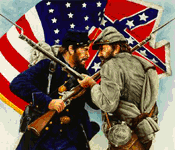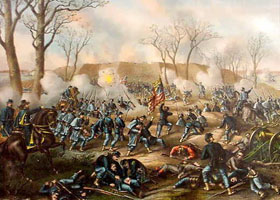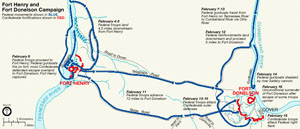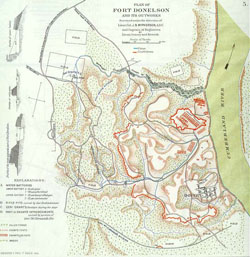 |
Civil War Battles |
|
State War Records |
| AL - AK - AZ - AR - CA - CO - CT - DE - FL - GA - HI - ID - IL - IN - IA - KS - KY - LA - MA - MD - ME - MI - MN - MS - MO - MT - NE - NV - NH - NJ - NM - NY - NC - ND - OH - OK - OR - PA - RI - SC - SD - TN - TX - UT - VT - VA - WA - WV - WI - WY |
The Battle of Fort Donelson
February 14-16, 1862 in Fort Donelson, Tennessee
 |
|||||||||||||||||||||
|
The capture of the Fort Donelson by Union forces opened the Cumberland River as an avenue of invasion of the South and elevated Brig. Gen. Ulysses S. Grant from an obscure and largely unproven leader to the rank of major general and the nickname "Unconditional Surrender" Grant.
Gen. Albert S. Johnston gave Brig. Gen. John B. Floyd command of Fort Donelson. Floyd arrived after losing western Virginia to Maj. Gen. George B. McClellan. Floyd was a wanted man in the North, for graft and secessionist activities as Secretary of War under the administration of President James Buchanan. Johnston gave him an additional 12,000 men and withdrew the rest of his force to Nashville to stop an expected Union attack there.
After capturing Fort Henry on February 6, Grant advanced cross-country to take Fort Donelson. Johnston had dispatched about 12,000 reinforcements from Bowling Green, Kentucky, under Floyd, to bolster the defense of the fort. Grant had wanted to move fast, to prevent reinforcements arriving at all, but rainy weather delayed him and the Confederate troops arrived safely.
Fort Donelson was a much stronger work than Fort Henry. It was much larger, with a stronger garrison, about 100 feet above the river, and on a ridge which narrowed routes for infantry attack. The fort had 12 heavy guns about 100 feet above the Cumberland River, and 3 miles of trenches in a semicircle around the fort, which was more of a stockade than a fort. It was considerably more formidable than Fort Henry. The Confederate line of trenches, located on a commanding ridge, backed up by artillery, was manned by Buckner on the right and Pillow on the left.

Grant's Union army consisted of 3 divisions, commanded by Brig. Gens. John A. McClernand, Charles F. Smith, and Lew Wallace. Supporting the infantry divisions were two regiments of cavalry and 8 batteries of artillery, altogether about 25,000 men. The naval squadron under U.S. Navy Flag Officer consisted of 6 ironclad and wooden gunboats including the flagship USS Cincinnati, USS Carondelet, USS St. Louis, USS Conestoga, USS Tyler, and the USS Lexington.
Floyd's force of approximately 20,000 men consisted of 3 divisions, garrison troops, and attached cavalry. The 3 divisions were commanded by Floyd himself and Brig. Gen. Gideon J. Pillow and Brig. Gen. Simon B. Buckner. The garrison troops were commanded by Col. John W. Head and the cavalry by Col. Nathan B. Forrest.
Grant reached the Union right at about 3:00 P.M. and pushed McClernand and Wallace to counterattack and retake the ground they had lost earlier in the day. Grant observed that the Confederates were fighting with filled knapsacks, which implied to him that they were going to attempt a breakout. He moved quickly to exploit the opening that the indecisive Floyd had left him and told Smith that "All has failed on our right—you must take Fort Donelson." Smith replied, "I will do it." Smith's counterattack quickly succeeded in seizing the outer line of entrenchments on the Confederate right, the brigade that had been left behind from Buckner's division. On the Union right, General Wallace formed an attacking column with three brigades—one from his own division, one from McClernand's, and one from Smith's. Col. Morgan L. Smith's brigade from Smith's Division was composed of 2 regiments formerly commanded by Wallace and it was chosen to lead the attack. By nightfall, all of the Confederate troops had been driven back to their original positions.

On February 13, several smaller probing attacks were carried out against the Confederate defenses. On the Union left Charles Smith sent a brigade to test the defenses along his front. The attack made no gains, but Smith was able to keep up sniping fire throughout the night. On the Union right, McClernand ordered an unauthorized attack along his front. Two regiments of William R. Morrison's brigade along with one regiment, the 48th Illinois, from W. H. L. Wallace's brigade were ordered to seize a battery that had been plaguing their position. Isham N. Haynie, Colonel of the 48th Illinois, believed he was the senior officer in the field. Although in command of two of the three regiments, Colonel Morrison volunteered to turned over command of the attack once it was under way When the regiments charged, neither officer took control and the leaderless attack was repulsed.
On February 14, Brig. Gen. Lew Wallce's Division arrived from Fort Henry and Flag Officer Andrew H. Foote's flotilla transporting another 10,000 Union reinforcements arrived, with 6 gunboats, four of them ironclads. Grant urged Foote to immediately attack the fort's river batteries. Just as he had done at Fort Henry, Foote moved his gunboats in close to the shore and opened fire. Waiting until the gunboats closed to within 400 yards, the Confederate gunners opened fire. The artillery pummelled the fleet. Foote was wounded and the wheelhouse to his flagship carried away. Uncontrollable, his flagship floated helplessly downriver. Fifty-four Union sailors were killed or wounded while the Confederates lost nothing. However, on land the Confederates were surrounded by well-armed Union soldiers, and while the Union boats had been damaged, they still controlled the Cumberland River. The Union soldiers settled in begrudgingly for a siege. They were hungry, many without adequate clothing, and they were enduring fierce winter winds that brought temperatures down to 12° F.
On February 15, the Confederates launched a dawn assault by Pillow against McClernand's division on the unprotected right flank of the Union line, in an attempt to gain the road to Nashville, their only means of retreat. The plan was for Pillow to push McClernand out of the way and for Buckner to move his division across Wynn's Ferry Road and act as rear guard for the remainder of the army as it withdrew from Donelson and moved east. One of Buckner's brigades was designated to stay in the trenches and prevent Union pursuit. The attack started well and after 2 hours of heavy fighting, Pillow's men were able to push McClernand out of the way and open the escape route. His attack was primarily successful due to the leadership of his second-in-command, Brig. Gen. Bushrod R. Johnson, and a flanking attack by Confederate cavalry under Forrest.
On February 16, Floyd expected a Confederate loss, and to be captured and face justice in the North. At a council of war at 1:30 A.M., he turned over his command to the indecisive Pillow, who also feared Northern reprisals and gave it in turn to the somewhat cautious Buckner; Floyd escaped down the Cumberland in the night; Pillow also escaped. Disgusted at this show of cowardice, Forrest heatedly said, "I did not come here to surrender my command," and stormed out, leaving with his 700 men. They traveled by a flooded trail paralleling the river, 15 minutes before the escape route was cut by McClernand. Despite seeing that his attack was successful, by 1:30 P.M. Pillow believed he should regroup his forces before pushing forward and, to the amazement of Floyd and Buckner, he ordered his men back to their trenches. At that moment, Floyd lost his nerve and, believing that Charles F. Smith's division was being heavily reinforced, ordered the entire defensive force back inside the lines of Fort Donelson.
Buckner sent a note that morning to Grant requesting terms of surrender. Buckner had expectations that Grant would offer generous terms because of their previous relationship. Grant's reply was one of the most famous quotes to come out of the war, giving him his nickname of "Unconditional Surrender"; in part:
" Sir: Yours of this date proposing Armistice, and appointment of Commissioners, to settle terms of Capitulation is just received. No terms except unconditional and immediate surrender can be accepted. I propose to move immediately upon your works."
I am Sir: very respectfully
Your obt. sevt.
U.S. Grant
Brig. Gen.
After the failure of their all-out attack aimed at breaking through Grant's investment lines, they had no choice. That night Floyd, with Pillow's approval, decided to surrender, but neither officer was willing to do the actual surrendering. That odious responsibility fell to Buckner. Floyd and Pillow, with about 2,500 men, escaped in boats, while Forrest and his cavalry left by the backwaters. On the morning of February 16, Buckner requested terms of capulation from grant, who insisted on unconditional surrender.
This was a major victory for Grant and a catastrophe for the South. It ensured that Kentucky would stay in the Union and opened up Tennessee for a Northern advance along the Tennessee River and Cumberland River. He received a promotion to major general for his victory and attained stature in the Western Theater, earning the nom de guerre "Unconditional Surrender."
Buckner shortly surrendered his 14,000 troops and 40 guns, the first of 3 Confederate armies that Grant would capture during the war. He also surrendered considerable equipment and provisions, which Grant's hungry troops needed badly. Over 7,000 Confederate prisoners of war were eventually transported to Camp Douglas in Chicago; others were sent elsewhere throughout the North.
The capture of Forts Henry and Donelson were the first significant Union victories in the war. Close to 1/3 of all Johnston's forces became prisoners; Grant had captured more Confederate soldiers than all previous Union generals combined. The rest of Johnston's forces were 200 miles apart between Nashville and Columbus with Grant's army between them controlling all rivers and railroads.
